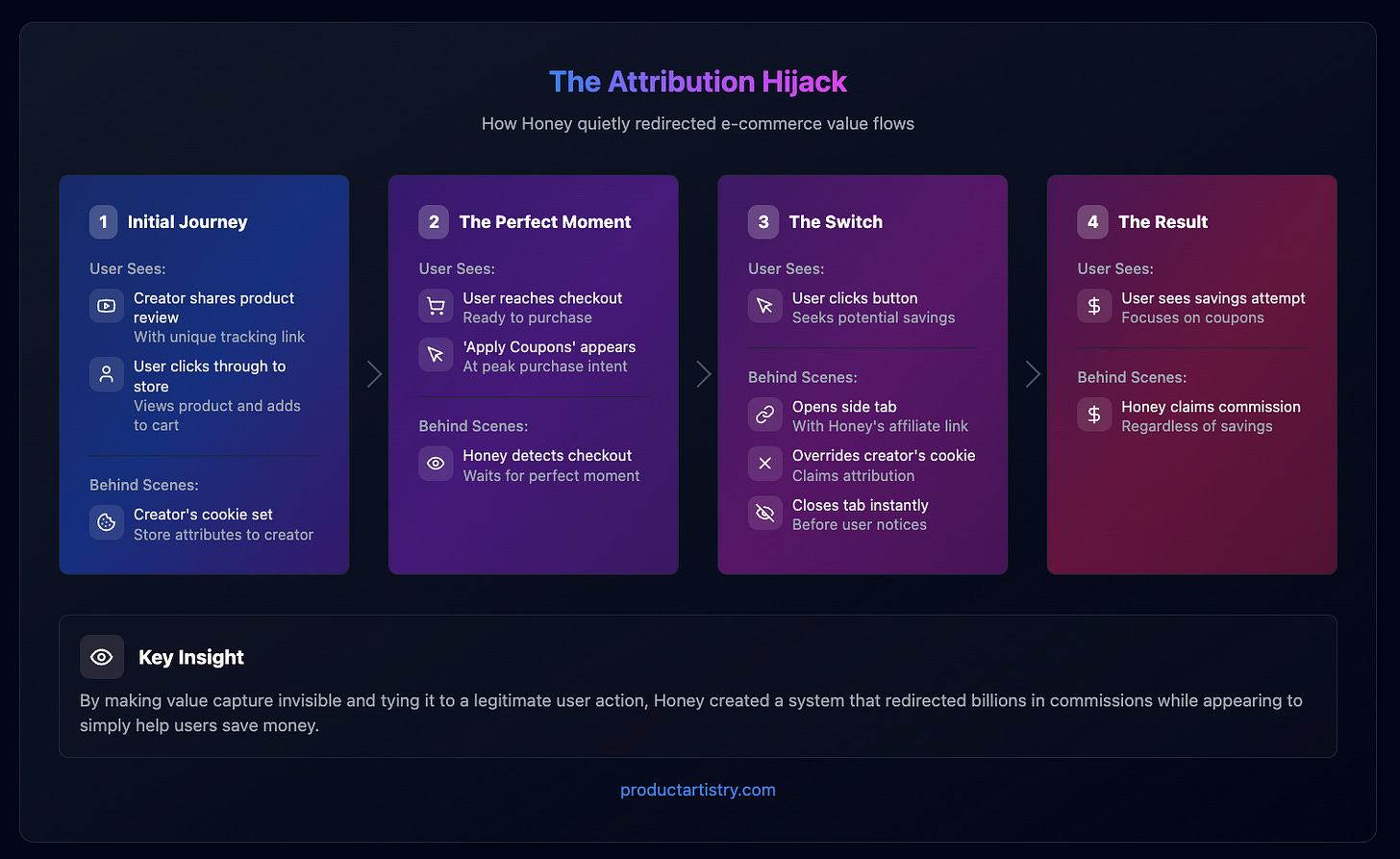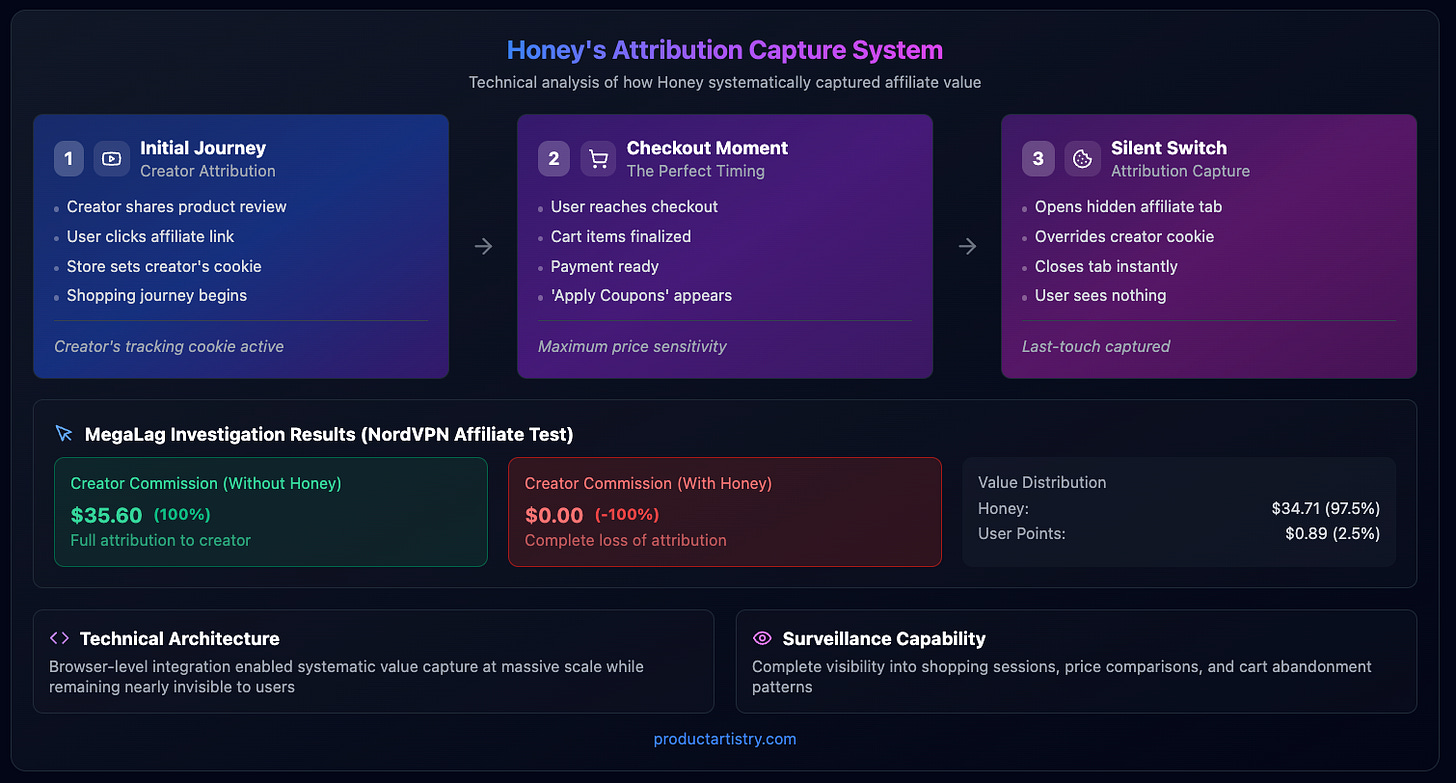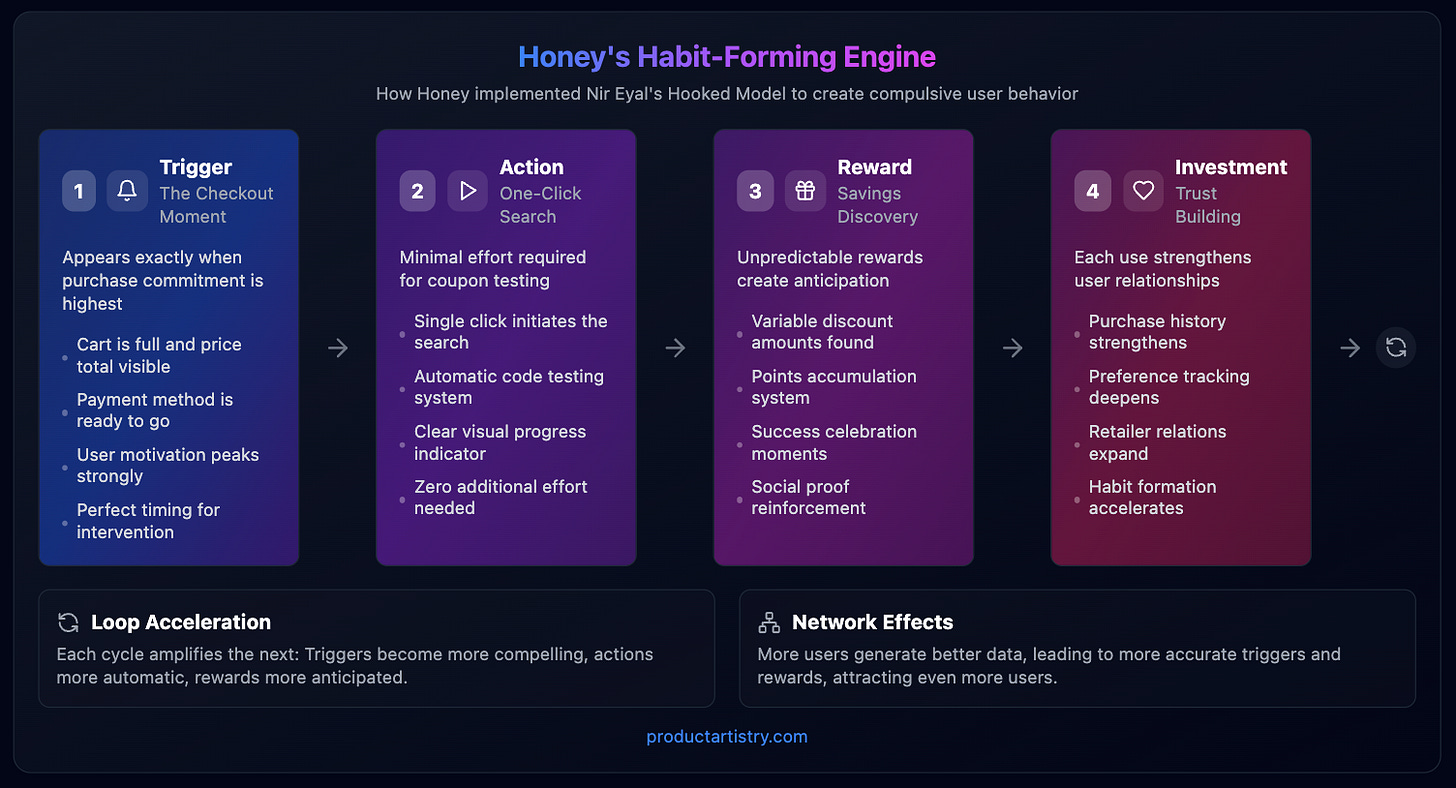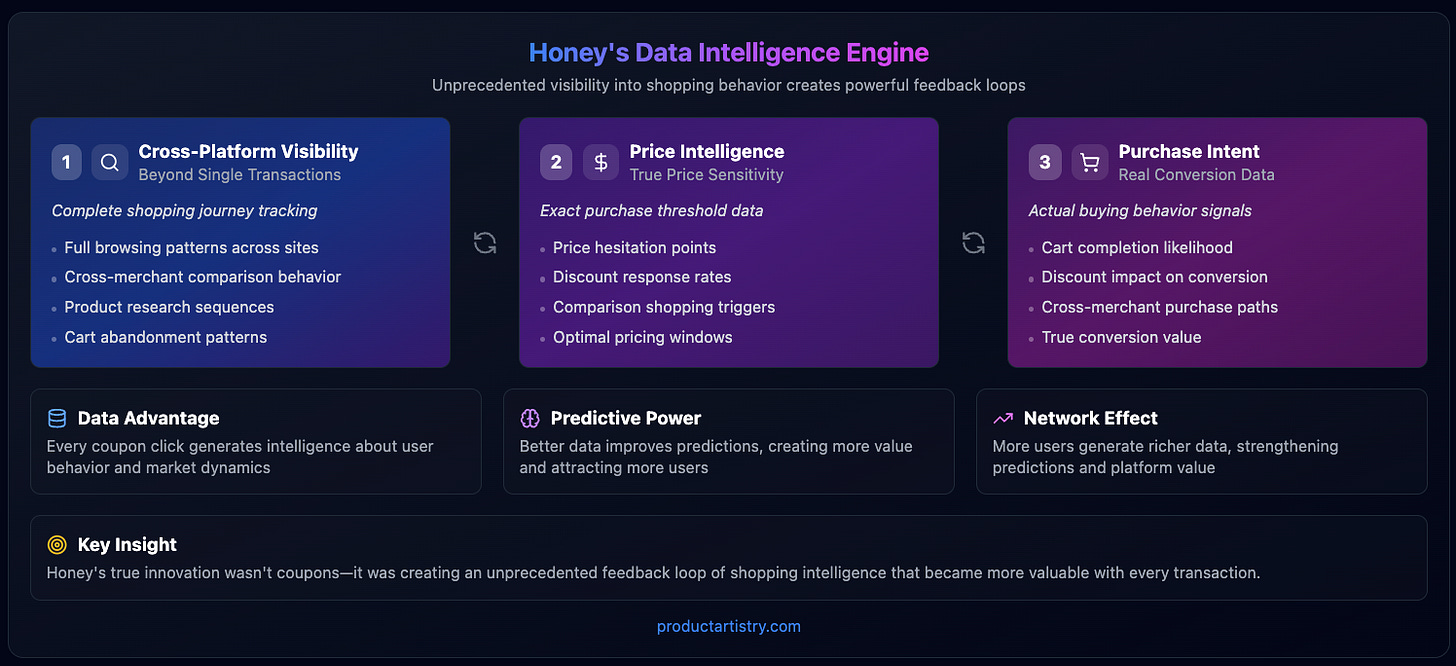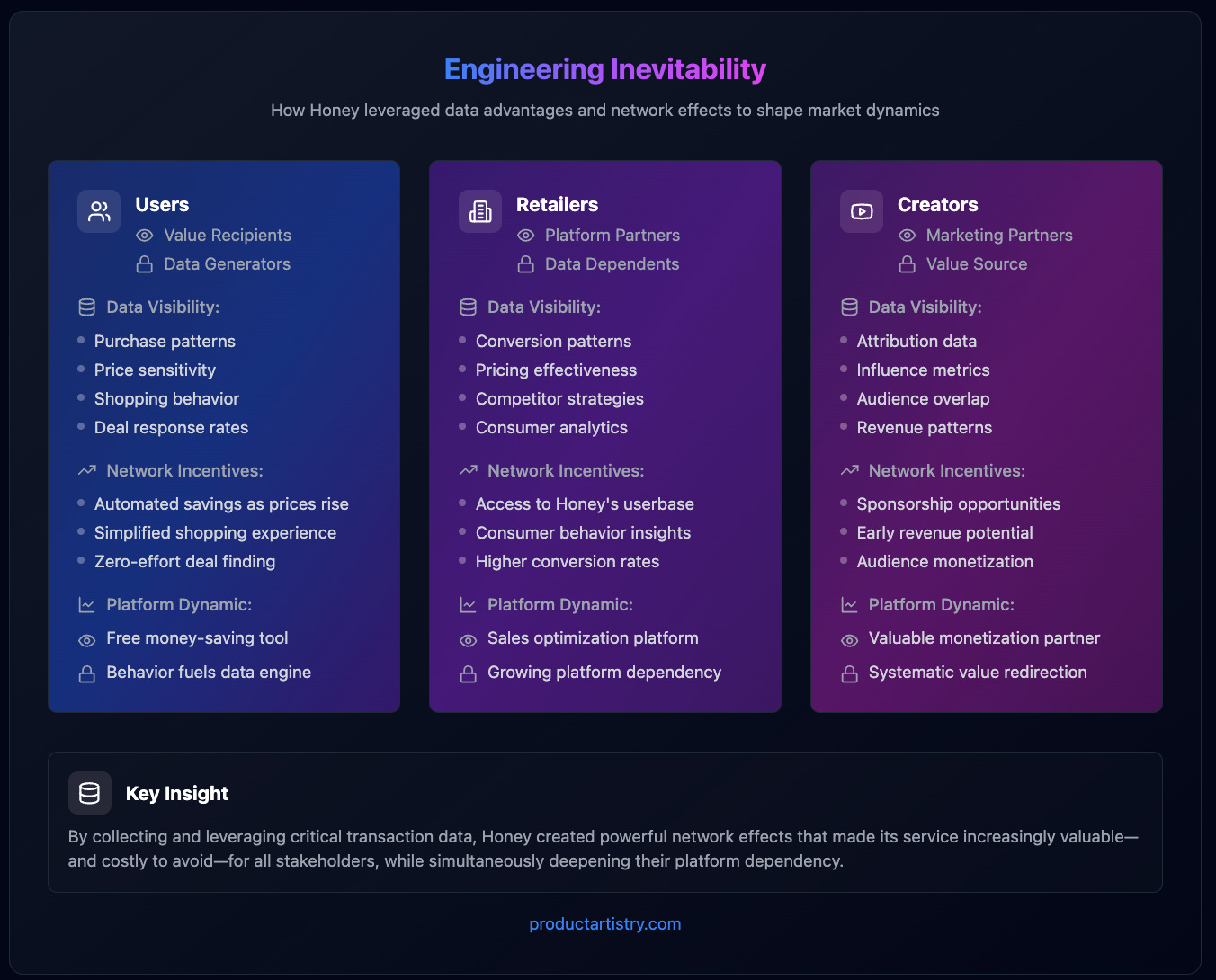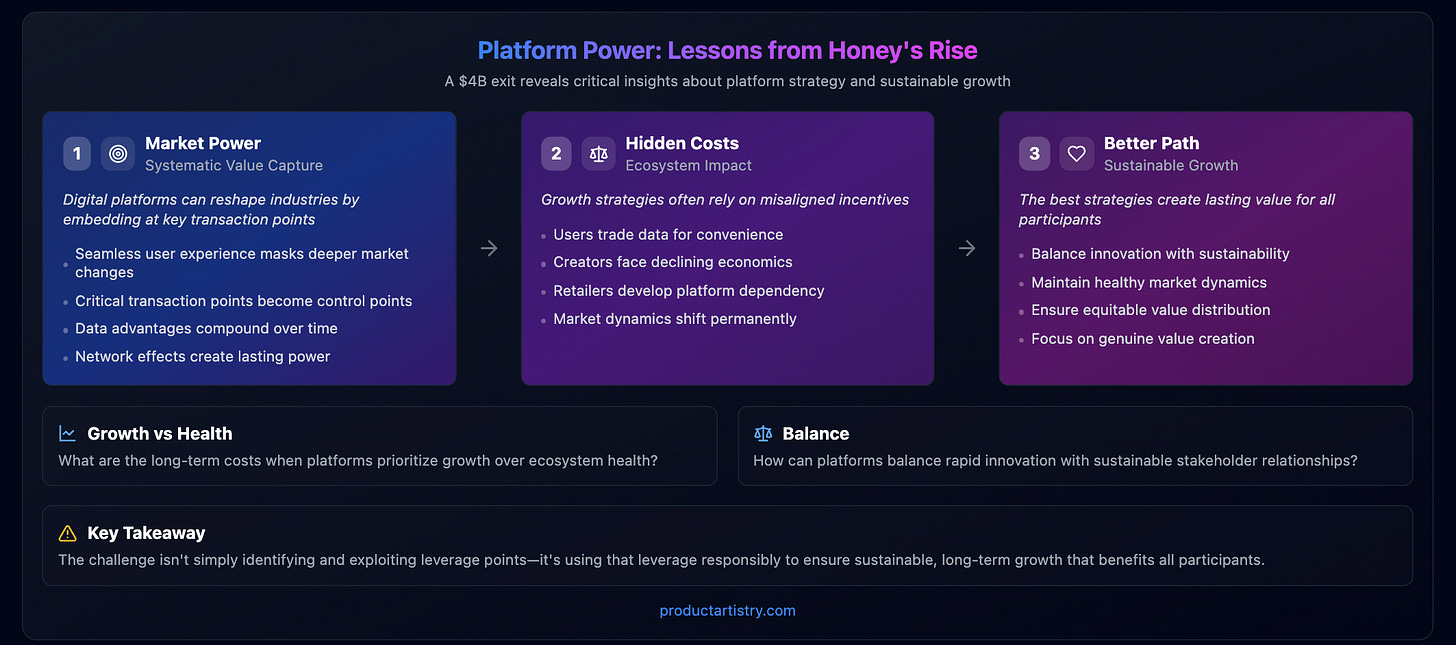Hidden in Plain Sight: Honey's $4B Strategy
How a Browser Extension Embedded Itself in E-commerce’s Most Valuable Moment
With every click of Honey's "Apply Coupons" button, millions of shoppers participated in reshaping e-commerce's most valuable moment: the instant of purchase commitment.
Behind the friendly gold coin mascot lay something far more strategic: a product designed to capture the most critical juncture in online shopping.
Most saw Honey as a simple browser extension that found discount codes. But that simplicity was its greatest strength. A recent viral investigation by YouTube creator MegaLag (whose in-depth video I highly recommend) revealed a more complex reality:
Silently adjusting affiliate tracking to capture commissions
Redirecting millions in commission revenue
Positioning itself between retailers and customers
Influencing behavior at the peak of the shopping journey
The genius of Honey’s strategy lay in making every stakeholder feel they were gaining, even as it quietly redefined how value flowed in e-commerce:
Users believed they were saving money effortlessly.
Creators were drawn in by attractive upfront sponsorship payments.
Retailers welcomed improved conversion rates and additional sales.
Yet beneath the surface, Honey fundamentally reshaped the dynamics of the marketplace.
By the time PayPal acquired Honey in 2020 for $4 billion in cash, the browser extension had embedded itself so deeply into online shopping that its influence was nearly impossible to displace.
This is a story about modern platform power: sometimes the most effective way to reshape an industry is to embed yourself in its most critical moments.
Let’s deconstruct how they did it.
1. The Fundamental Strategy: Control the Checkout
Every successful platform needs a wedge—a strategic entry point that unlocks disproportionate power. Honey found theirs in a profound insight: whoever controls the checkout moment controls e-commerce itself.
While competitors focused on discovery and browsing, Honey targeted the single most valuable microsecond in online shopping: the moment you commit to purchase. This wasn’t a random choice—it was a deliberate strategy based on three critical advantages:
Users were psychologically primed to take action.
Attribution systems were vulnerable to manipulation.
The potential for value capture was highest at this stage.
But identifying this opportunity was just the beginning.
1.1. The Attribution Hijack
At the heart of Honey’s strategy was something most users never consider: how online stores track who gets credit for a sale. In e-commerce, the predominant system used is called last-touch attribution—the commission goes to whoever interacted with the customer last, even if someone else did all the work to drive the sale.
Think of it like this: A YouTuber reviews a product, and you click their link to buy it. In theory, they should get credit for the sale. But if you interact with Honey before completing your purchase, it overrides their credit entirely.
Here’s how it worked:
Initial Journey:
A creator shares a product review with their unique affiliate tracking link.
You click through to the store, add items to your cart, and proceed to checkout.
Behind the scenes, the store sets the creator’s tracking cookie to credit them for the sale.
The Perfect Moment:
You reach the checkout page, ready to purchase.
Honey’s “Apply Coupons” button appears—exactly when price matters most.
Behind the scenes, Honey monitors this precise moment.
The Switch:
You click the tempting “Apply Coupons” button, hoping to save.
Behind the scenes, Honey silently:
Opens a side tab with its own affiliate link.
Overrides the creator’s tracking cookie.
Closes the tab instantly, ensuring you never notice.
The Result:
You see whether any coupons worked.
Behind the scenes, Honey claims the commission value—regardless of whether savings were applied.
Most users never realized what happened. Their focus was on potential savings, not the invisible manipulation in the browser backend. Even if no coupons worked, Honey still captured the commission value.
Example: The MegaLag Investigation
MegaLag's controlled test using his own NordVPN affiliate links revealed the stark reality of Honey's value capture:
Without Honey: MegaLag, as the original referrer, earned the full $35.60 commission for a NordVPN sale.
With Honey: The platform redirected 97.5% of the value ($34.71) to itself.
Creator earned: $0.
User received: $0.89 in rewards points for facilitation (2.5% of the original value).
This test demonstrated how Honey leveraged its position at checkout to redirect commissions, even when coupons didn’t provide any additional savings.
This wasn’t just clever engineering—it was systematic value capture at scale. Honey positioned itself perfectly:
Legitimacy: Users had a compelling reason to click (potential effortless savings).
Timing: It struck at peak purchase intent when users were most receptive.
Invisibility: The redirection happened seamlessly, unnoticed by users.
By controlling the checkout moment, Honey wasn’t just offering potential savings—it was quietly redirecting millions in commission revenue, all while users remained unaware.
1.2. The Technical Innovation
Honey’s success wasn’t just about finding coupons—it was about leveraging browser-level integration to operate at massive scale. By embedding itself in the browser, Honey unlocked capabilities that traditional platforms couldn’t match:
Real-Time Monitoring: Honey observed shopping behavior, tracked price sensitivity, and mapped user journeys across thousands of sites, all while presenting itself as a simple coupon tool.
Seamless Integration: The extension worked behind the scenes to streamline affiliate tracking, optimize attribution, and ensure a frictionless user experience.
Unbounded Scalability: Honey operated globally, adapted to virtually any retailer’s site, and scaled effortlessly to millions of users.
This was more than just clever engineering—it was a strategic innovation. Honey positioned itself directly in the checkout flow, capturing value at the most critical moment of the user journey.
Unlike traditional platforms that relied on retailer partnerships, Honey’s browser-based approach allowed it to operate independently, integrating with purchase flows across the web.
Honey wasn’t just a coupon finder. It became an invisible layer that bridged users and retailers—delivering value, learning from interactions, and optimizing its approach—while remaining nearly invisible.
1.3. The Data Advantage
Honey’s universal positioning gave it something even more valuable than commission revenue: unprecedented insight into online shopping behavior. Every user generated data that reinforced Honey’s position:
Purchase Intent: By analyzing customer behavior, Honey mapped the triggers behind buying decisions.
Price Sensitivity: It identified the discounts that drove purchases across categories and demographics.
Cross-Platform Intelligence: With visibility across thousands of retailers, Honey uncovered patterns no single merchant could access.
This data advantage created a powerful flywheel effect:
Better data led to deeper insights.
Deeper insights strengthened retailer relationships.
Stronger relationships drove more user adoption.
More users generated even richer data.
Retailers increasingly relied on Honey’s insights to optimize pricing, predict trends, and understand customer behavior across the shopping journey.
While users saw a tool for saving money, Honey was quietly building one of the most sophisticated e-commerce intelligence platforms in the world.
2. The Perfect Moment: Engineering Trust Through Psychology
Building the infrastructure to capture attribution was only half the battle. Honey needed users to willingly trigger it—and their solution was brilliant in its simplicity.
2.1. The Perfect User Moment
Picture this: You’re at checkout, cart full, credit card in hand. The total feels steep. Then, a small modal appears: “5 Coupons Found! Apply Coupons?”
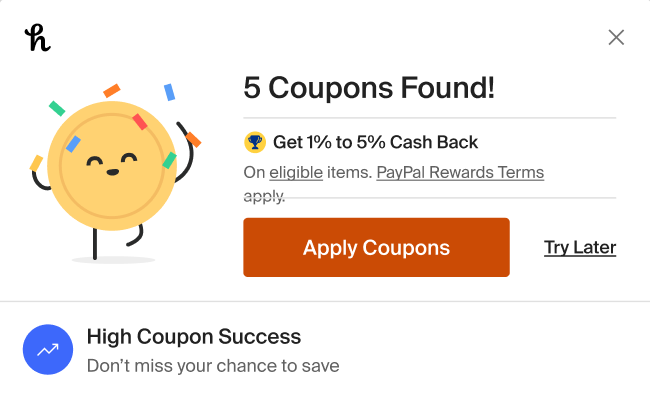
What happens next is a masterclass in behavioral design:
If coupons work: Your total drops instantly—a dopamine hit that validates both your purchase and Honey’s value.
If coupons fail: You still earn PayPal Rewards points for trying, ensuring every interaction feels like a win.
This wasn’t just clever design—it was a textbook implementation of
’s Hooked Model for habit-forming products:Trigger: The checkout moment creates price anxiety.
Action: The “Apply Coupons” button offers an effortless solution.
Variable Reward: Either savings or reward points ensure user satisfaction.
Investment: Each successful use builds trust and a habit for future purchases.
Behind this simple interface, Honey was executing a fine-tuned psychological system designed to maximize engagement:
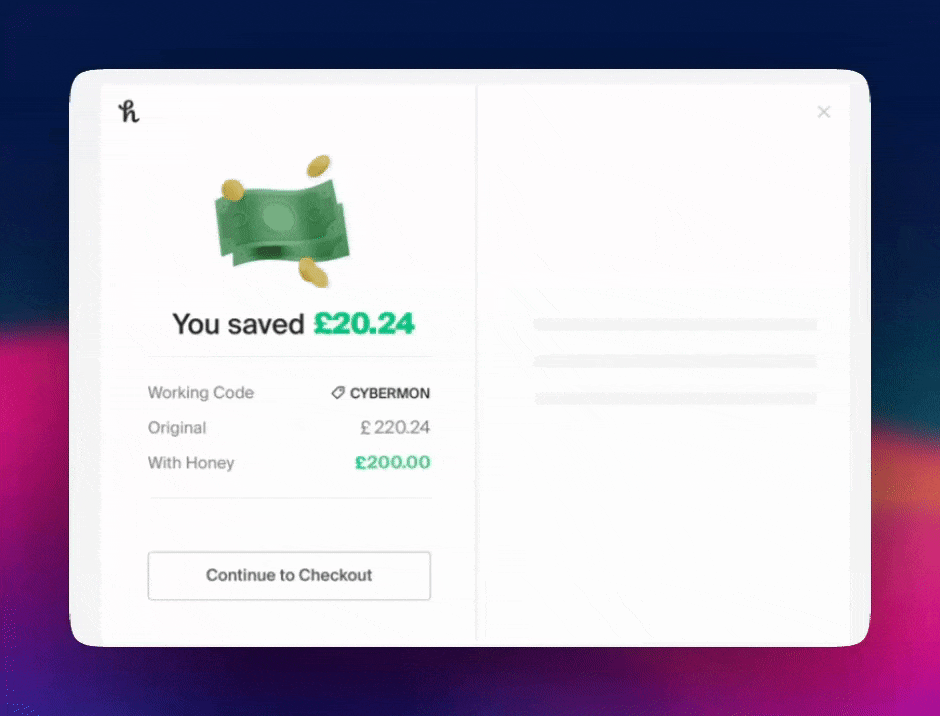
Show the Work: Users saw Honey visibly testing multiple codes, creating trust through transparency.
Guarantee a Win: Whether through savings or rewards, users always left feeling they’d gained something.
Create Zero Risk: Clicking the button had no downside but promised plenty of potential upside.
2.2. The Frictionless Design
Honey’s brilliance extended beyond psychological hooks—it eliminated every possible barrier to adoption for the product:
Zero Cost: Free to install, with no perceived risk.
Zero Effort: Automatically worked across thousands of sites.
Zero Learning: A simple, intuitive interface required no training.
Zero Wait: Users saw immediate value from their very first use.
This seamless experience transformed Honey from a niche tool into a universal shopping companion. Users didn’t have to remember to use it, configure settings, or navigate complex features—it was always there, ready to help.
2.3 The Perfect Product-Moment Fit
This combination of psychological hooks and frictionless design wasn’t just good product thinking—it was perfect strategic positioning. Honey identified the ideal moment to integrate itself into e-commerce:
Peak Psychological Vulnerability: Users felt the most price anxiety just before completing a purchase.
Lowest Resistance: The decision to buy was already made, removing major friction.
Maximum Value Perception: Savings felt the most rewarding at checkout.
Perfect Attribution Timing: Users triggered the commission capture themselves.
This positioning allowed Honey to serve multiple strategies at once:
For Attribution: Enabled Honey to override creator cookies at checkout.
For Data: Captured purchase intent at its most revealing point.
For Trust: Demonstrated value when users needed it most.
For Lock-in: Created an association with the satisfaction of saving.
By owning this critical moment, Honey didn’t just position itself as a helpful browser extension—it became the gatekeeper of purchase completion.
3. The Market Power Play: How Honey Shaped the Game
Honey's success wasn’t just about technology or psychology—it was about creating a system where data insights shaped user behavior and market dynamics. By collecting and analyzing critical transaction data, Honey built a unique information advantage that powered its strategy.
At the checkout moment, Honey would have visibility into:
Purchase patterns and price sensitivity across user segments.
Attribution data showing which creators influenced sales.
Real-time pricing and discount strategies from retailers.
Conversion data and cart abandonment patterns.
This data advantage allowed Honey not just to observe but to strategically influence the marketplace. It optimized when and how to surface deals, targeted promotions effectively, and strengthened its position with both shoppers and retailers through data-driven decision-making.
3.1. Engineering Inevitability
Honey created powerful network effects and incentive structures that made participation increasingly valuable—and costly to avoid—for all stakeholders:
Users: Relied on automated savings, especially as prices rose, making Honey indispensable for deal-seeking shoppers.
Creators: Were drawn to Honey’s lucrative sponsorship model, even as it subtly increased their dependence on the platform.
Retailers: Valued Honey’s consumer behavior insights and sales boosts, particularly in the face of competition from giants like Amazon.
By aligning these incentives and creating high switching costs, Honey evolved from a simple coupon tool into a dominant e-commerce intermediary.
3.2. The Retailer's Dilemma
Honey presented retailers with a compelling yet complex value proposition:
Benefits of Partnership
Access to Honey’s growing user base and increased conversion rates.
Revenue via affiliate commission structures.
Consumer behavior analytics offering valuable insights.
Some control over discount strategy and promotion timing.
Integration with a widely used e-commerce platform.
Costs of Non-Participation
Risk of losing price-sensitive customers to competitors using Honey.
Limited visibility into shopping patterns and market trends.
Honey users could still find and apply coupons, bypassing retailer influence.
A perception of being less consumer-friendly in a deal-driven market.
While partnering with Honey offered immediate sales and market benefits, it also shifted market power over time. Retailers would become increasingly reliant on Honey for customer acquisition and retention, further deepening the platform’s influence.
3.3. The Creator’s Strategic Trap
Honey’s relationship with creators revealed a tension between short-term benefits and long-term dependency:
Initial Partnership Benefits
Lucrative sponsorship deals provided attractive revenue opportunities.
Marketing messaging aligned with creator goals, fostering trust.
Early adopters saw strong returns, reinforcing positive perceptions.
Evolving Revenue Impact
Affiliate tracking was overridden at checkout.
Commission attribution shifted to Honey.
Honey captured significant value from creator-referred traffic.
Even creators who recognized this dynamic were trapped. As Honey’s user base grew, the likelihood of viewers using the extension increased, systematically eroding affiliate revenue—regardless of the creator’s actions.
3.4. The User Capture
While users appeared to benefit the most, they were also central to Honey’s growth and market dominance:
Building Loyalty: Consistent savings turned Honey into a trusted shopping companion, driving repeat usage.
Word-of-Mouth Marketing: Positive experiences encouraged users to share Honey with others, creating organic growth.
Driving Network Effects: Each user interaction enriched Honey’s data engine, amplifying its influence across retailers and creators.
Honey turned user behavior into a self-reinforcing growth engine and a competitive moat. The more users joined, the stronger Honey’s position became, creating a cycle that was difficult for competitors to disrupt.
3.5. The Perfect Game
Honey’s success lay in crafting distinct perceptions for each stakeholder group:
Users saw:
Perception: A free tool delivering automatic savings.
Reality: Their shopping behavior fueled Honey’s data engine and market power.
Retailers saw:
Perception: A powerful sales optimization platform.
Reality: Growing dependency on Honey for customer acquisition and insights.
Creators saw:
Perception: A valuable marketing and monetization partner.
Reality: Systematic redirection of affiliate revenue to Honey.
Honey’s multilayered strategy demonstrated mastery of platform dynamics: while stakeholders perceived immediate benefits, their engagement deepened Honey’s control over the market.
Through consistent value delivery, Honey grew its ecosystem while embedding dependencies at every level.
4. Conclusion: The Hidden Cost of Platform Power
Honey’s rise shows how digital platforms can transform industries by embedding themselves at critical transaction points—delivering seamless user value while quietly reshaping how the market operates. Their $4 billion exit wasn’t just a triumph of engineering; it was a masterclass in systematic value capture.
One theme stands out: Honey’s success was built on a deep understanding of user psychology, precise market positioning, and the ability to leverage data at scale. Yet, their story also highlights the risks of growth strategies fueled by misaligned incentives:
Users saved money but unknowingly participated in revenue redirection.
Creators enjoyed early rewards but saw declining earnings as commissions shifted.
Retailers benefited from tools and insights but would become increasingly dependent on Honey’s ecosystem.
These dynamics leave us with pressing questions about the future of platform strategies:
What are the long-term costs when platforms prioritize growth over ecosystem health?
How can platforms balance rapid innovation with sustainable stakeholder relationships?
Is there a fundamental tension between platform scale and equitable value distribution?
Honey’s playbook offers both inspiration and caution for the next generation of platform builders. The challenge isn’t simply identifying and exploiting untapped leverage points—it’s about using that leverage responsibly to ensure sustainable, long-term growth.
It’s clear that powerful platforms can be built—Honey proved that decisively. The real challenge lies in creating platforms that maintain healthy market dynamics and ensure growth comes from genuine value creation, not zero-sum games.
Sometimes, the cleverest strategy isn’t the best one. The best strategies create lasting value for everyone involved.
Note: This analysis is based on publicly available information. Some technical details involve informed speculation rather than definitive claims about specific business practices.
Three ways to help support my work:
Like, Comment, and Share—Help increase the reach of these ideas.
Subscribe for free—Get future posts and join our community.
Become a paid subscriber—Support my independent journey.
Keep Iterating,
—Rohan
→ Connect with me: LinkedIn, Bluesky, Threads, X, or Email—I’m always open to interesting conversations and opportunities!





